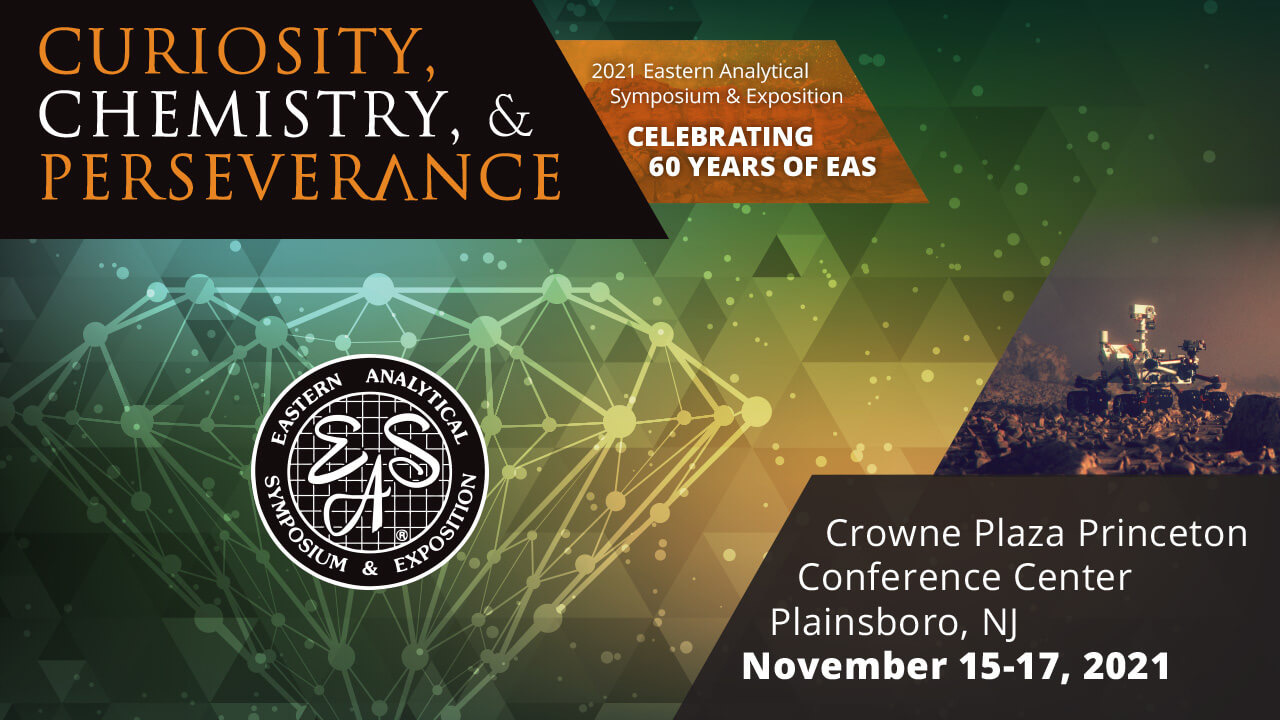
Oral presentations in High Performance Thin Layer Chromatography technical session at Eastern Analytical Symposium (EAS).
by Dr. Wilmer Perera, member HPTLC Association - North America Chapter
On November 15th to 17th, 2021 the EAS was held at Plainsboro, NJ/ USA. A technical session entitled: “High Performance Thin Layer Chromatography” chaired by Dr. Leonel Santos was scheduled on Monday, November 15th in the morning session. The technical program gathered four lectures, listed below.
1- A Validated High-Performance Thin-Layer Chromatography Method for Monitoring Glucose and Malto Oligosaccharides with Multiple Degree of Polymerization During Bioethanol Production from Corn Biomass. Mckenzie Britt and Wilmer Perera, CAMAG Scientific, Inc.
2- HPTLC/MS Analysis of Banisteriopsis caapi and Psychotria viridis for the Purpose of Determining Variability Among Different Accessions of the Active Compounds with the Intention of Predicting the Quality and Potential Efficacy of the Ancient Amazonian Therapeutic Botanical Medicine Admixture, Ayahuasca. Sidney Sudberg, Alkemist Labs
3- Identification of Elderberry (S. nigra) Using HPTLC, HPLC and UV-Vis and Detection of its Adulterants in the World of Dietary Supplements, Brittany Brodziski, Erica Deprey, Adam Hoffman, Nature's Way
4- Separation of Tryptamine Based Hallucinogens Using HPTLC, Kelsey Patterson, Jeanne Berk, Thomas Brettell, Cedar Crest College, Matthew Wood, Ocean County Sheriff's Department
1- Abstract
Bioethanol production is a process of sugar fermentation to yield ethanol, representing renewable energy resources starting with plant-based biomass. Corn has been widely used to produce ethanol due to the large amount of carbohydrates (specifically starch) produced in the endosperm of the kernel. The use of bioethanol reduces fossil fuel consumption and consequently its negative impact on the environment. The fermentation process of most bioethanol plants in U.S is monitored by High-Performance Liquid Chromatography (HPLC). The HPLC methods range from 21 to 42 min and can simultaneously detect glucose, maltose and maltotriose. However, maltotetraose and sugars with the highest degree of polymerization are not resolved by HPLC. A high-performance thin-layer chromatography (HPTLC) method was developed herein for monitoring the fermentation process during bioethanol production from corn biomass. The method separates glucose and malto oligosaccharides (DP2 to DP8), and sugars can be detected after derivatization and quantified by using densitometric analysis on the same plate, thus the profile of individual sugars can be evaluated in detail during the fermentation process. Up to 20 samples can be analyzed simultaneously on one plate in less than two hours and results from different plates can be compared since an appropriate system suitability test has been developed. The feasibility of the method was evaluated using samples from different fermenter vessels at different times and the method was validated. The HPTLC method herein improves the turnaround of the process, thereby saving costs. The automation of the HPTLC process will also be discussed.
2- Abstract
HPTLC/MS analysis of various marker and active compounds found in the ancient botanical medicine admixture of two herbs, Ayahuasca, found in the Amazonian Jungle, by analyzing at least three phytochemical fractions of the plants with the intention of minimizing the therapeutic variability of the medicine as applied to its medical applications. With the application of Video Densitometry for the purpose of overall relative concentration of various marker and active compounds, as well as Mass Spectrometry, for the accurate determination of specific compounds, quality of the finished product may someday be predictable. The alkaloid, flavonoid & triterpene fractions analyzed will be utilized as Fingerprints for determination of Identity and will also be compared to one another for determination of consistency of crude raw material, from lot to lot, as well as different geographic locations, seasonal harvesting, etc.
3- Abstract
European elder (Sambucus nigra) berry has had a long-standing use in herbal medicine. With COVID-19 on the rise in 2020, the demand for a natural boost to the immune system brought elderberry to the forefront of dietary supplements and herbal medicines. The increase in demand is analogous with an increase in adulteration. Nature’s Way used an orthogonal approach to confirm quality ingredients were sourced, testing raw materials by HPTLC, HPLC and UV-Vis. Competitor products were also pulled from the shelves and tested, with a significant number showing low quality or adulteration.
4- Abstract- DEA License # - RQ0342535
Traditional thin-layer chromatography (TLC) has been one of the analytical techniques used for the analysis of common hallucinogenic tryptamines over the years. Using traditional TLC does not always provide a satisfactory level of sensitivity, resolution, or documentation to analyze all these compounds many of which may be closely related structural isomers/analogs. The goal of this project was to evaluate high-performance thin-layer chromatography (HPTLC) with various mobile phase systems to determine the optimum conditions for the separation of 12 natural and synthetic hallucinogenic tryptamines including the commonly analyzed bufotenine, psilocin and psilocybin. Visualization was performed by spraying each plate with p-dimethylaminobenzaldehyde (p-DMAB). Seven different mobile phase systems were investigated to determine which produce optimal separation for all the compounds. Out of the seven mobile phases, 100:1.5 methanol: ammonium hydroxide (mobile phase 1), 2:1:1 n-butanol: water: glacial acetic acid (mobile phase 2), and 100:1.5 methanol: glacial acetic acid (mobile phase 7) produced the most successful results. These three mobile phase systems were able to provide RF values that spanned the majority of the plate while also resulting in good resolution between each of the compounds. Using any three of these mobile phases in conjunction with p-DMAB shows promising results when trying to distinguish between psilocin, psilocybin, bufotenine, and 9 other tryptamine compounds. The results suggest that HPTLC is a useful and suitable method for separating common tryptamine hallucinogens while incorporating adequate sensitivity, good resolution, along with providing proper documentation, and ecofriendly science.
Download the presentations as pdf-files:
Comments
Leave a comment